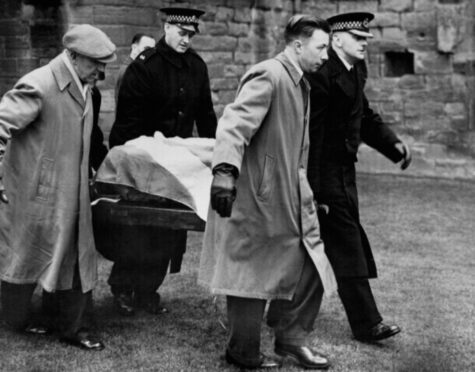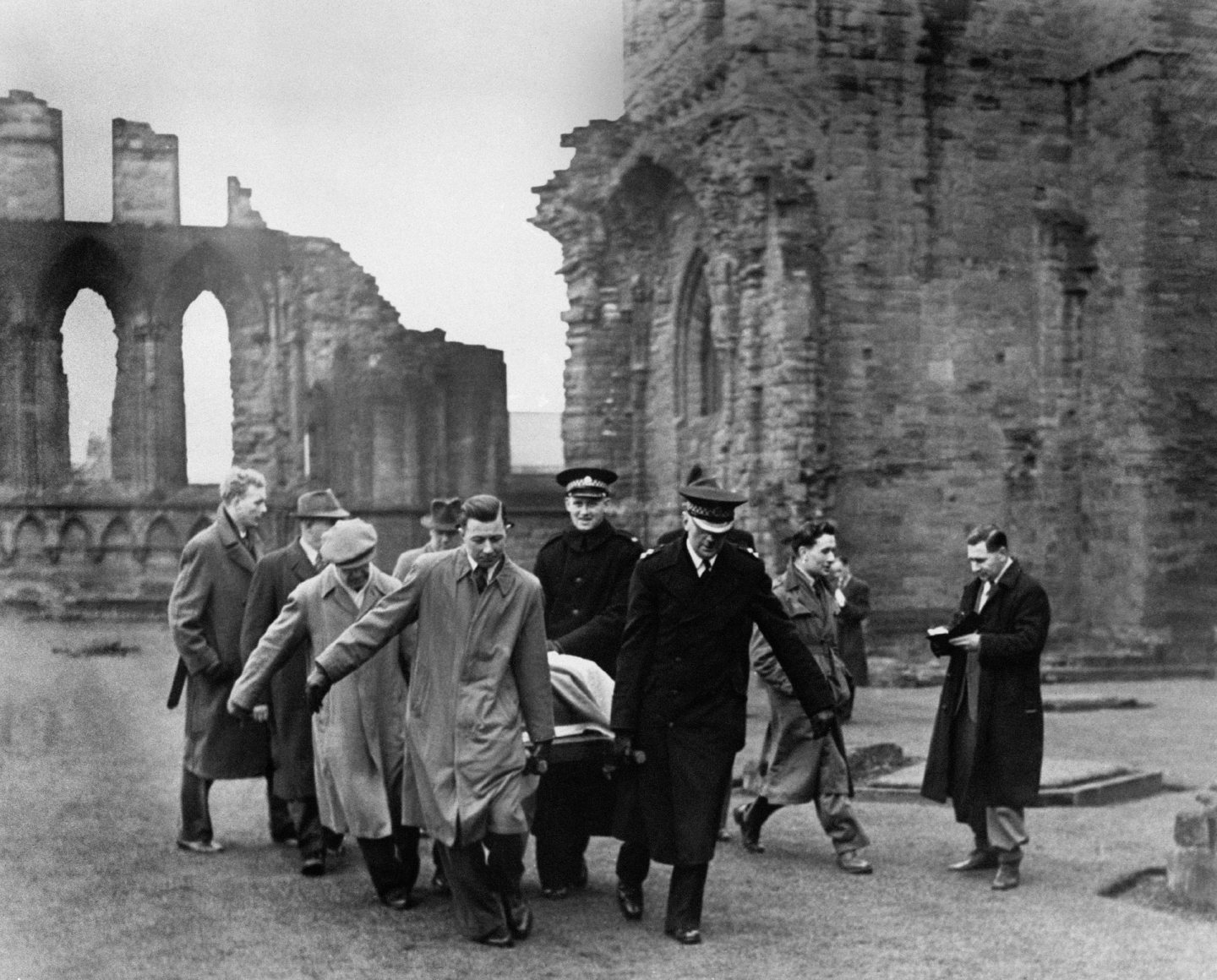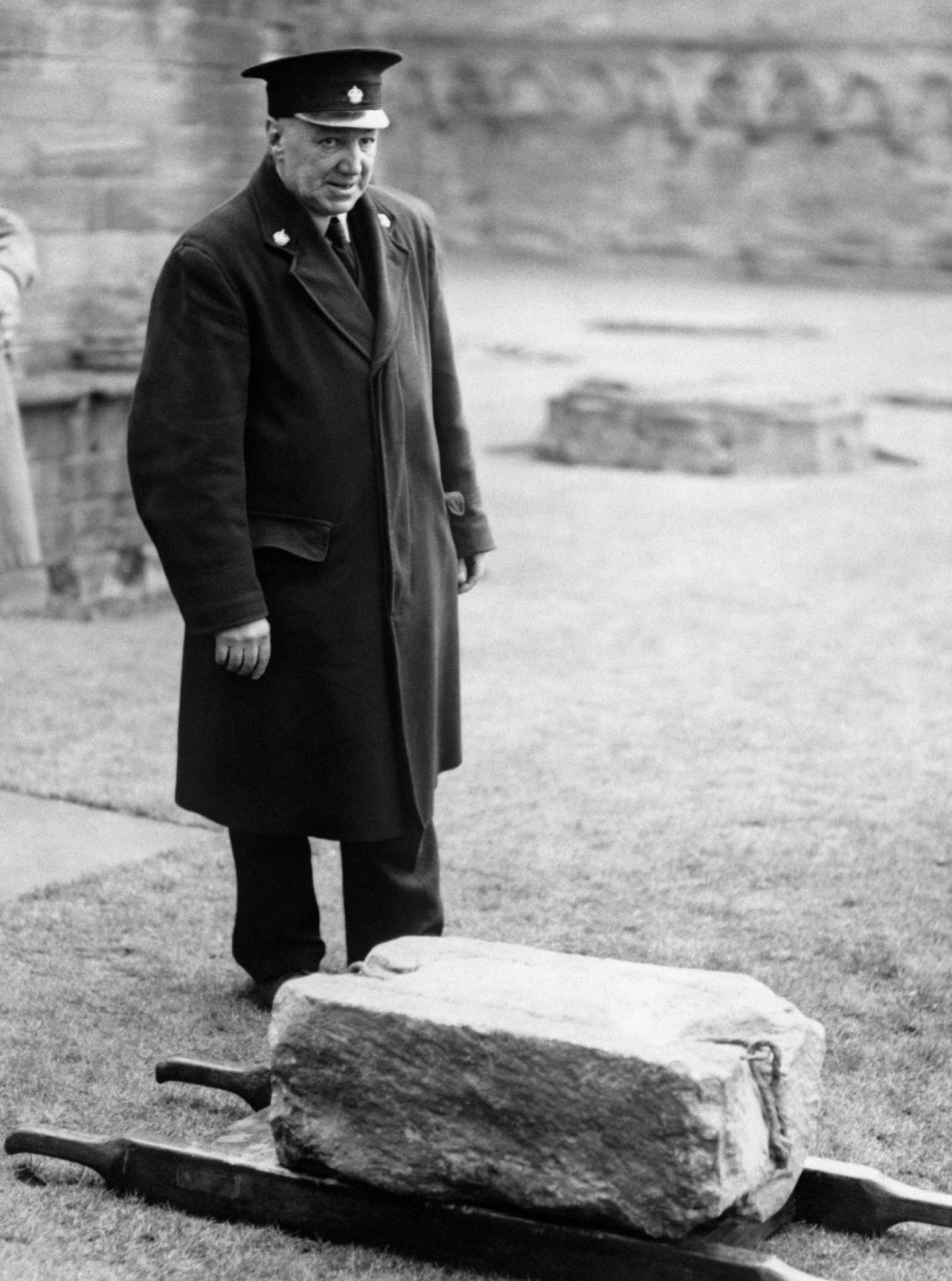
Since the time of Alexander III, the Stone of Scone, known popularly as the Stone of Destiny, had played a symbolic role in the assumption of royal power.
The sandstone block, weighing 336lb, was removed from Scone Abbey in Perthshire by King Edward I’s men in 1296 and placed in Westminster Abbey, where it became a focus for nationalist resentment. Many dreamt of returning it to its rightful place at Arbroath Abbey. A valiant and briefly successful attempt was made early on Christmas Day in 1950 by Ian Hamilton, who died in October aged 97, and three fellow Glasgow University students.
Along with Gavin Vernon, Kay Matheson and Alan Stuart, he broke into Westminster Abbey and took the Stone from beneath the Coronation Chair built by Edward.
The theft, when discovered, would lead to the border between Scotland and England being closed for the first time in 400 years. But the Stone was brought back to Scotland before being left at Arbroath Abbey in April 1951.
Hamilton and his accomplices would be charged but never prosecuted, and the Stone would be returned permanently to Scotland in 1996.
Here, in an account republished in Rosemary Goring’s anthology Scotland: The Autobiography, Hamilton, who went on to become an eminent lawyer, describes the audacious Christmas caper.
We vaulted the railings, and crossed the patch of light, and stood crucified by the rays of the lamp, against the shining door. At least we should not work in darkness.
We were desperately afraid of noise, and with the sharp end of the jemmy chewed away sufficient wood to enable us to prise the blade between the two sections of the door. At each creak we expected a police car, summoned by the watchman, to sweep up the lane. Let it come; at least we were going down fighting.
I could now put my fingers through and feel the hasp on the inside. It was slack. We prised up the bottom of the door, and it came clear of the ground, bringing the bolt with it. Our gap widened to three inches. We could see into the Abbey. There was no watchman waiting there.
We put the blade of the jemmy close behind the padlock, and together we all wrenched mightily. With a crash, the door flew open. In the car Kay heard the noise and shuddered, but the way to the Abbey was open. We swept in. I returned and pulled the doors close behind me. I had rehearsed that part.
A light glowed dimly at the west end of the nave, but the rest was in black darkness. We went down the transept in silent hurry, and found that the gate in the metal grill was open. We crept through and round and up into the Confessor’s Chapel. We did not listen for the watchman, for we might have heard him coming. At least, we would touch the stone.
The chapel was in darkness. The glimmer from my torch showed the glass doors into the sanctuary as black sheets, and I hastily turned it to the side where it shone wanly on the green marble tomb of Edward I, whose dead bones Bruce had feared more than he feared any living Englishman.
The other two had already lifted aside the rail which kept the public from the Chair. The Stone was before us, breast high, in an aperture under the seat of the Coronation Chair, raised 3ft from the floor on a kind of trestle. We gently prised at the bar of wood, which ran along the front as a retainer for the Stone. It was dry with age, and it cracked and splintered.
The Stone should now theoretically have slipped out, but it was a very close fit and its weight made it unwieldy. I got to the back and pushed, and it moved a little. The chains on its sides kept catching on the carved sides of the Chair and, since the three of us were working in a sweating fever, not one of us had the patience to hold the light.
At last we saw that brute strength and black darkness would not budge it, so we called a halt. Then one man holding the torch, one prising at the sides with the jemmy, and one pushing at the back, we started afresh. It moved. It slid forward. We had moved the Stone. The English Chair would hold it no longer.
It was almost free. One last heave. “Now!” said Gavin. I pushed from the back. It slid forward and they had it between them. I rushed forward to help them and we staggered a yard. We had to put it down. It was too heavy.
“A coat!” said Alan deep in his throat.

“Mine is the strongest,” I said. It was the strongest, but also I wanted the honour for my coat. I struggled out of my coat and laid it on the ground; one hasty heave and the Stone was on the coat.
I seized one of the iron rings, and pulled strongly. It came easily – too easily for its weight, and I felt something uncanny had happened. “Stop!” I said and shone my torch.
I shall not forget what the faint light revealed, for I had pulled a section of the Stone away from the main part, and it lay in terrifying separation from its parent. I was going to be sick. Better to howl and bring the watchman and have it repaired than carry away a broken Stone.
“We’ve broken Scotland’s luck,” came Alan’s whisper. I shone the torch on the break. Suddenly I saw the greater area of the break was much darker than the thin wafer round the top edge. The Stone had been cracked for years, and they had not told us.
“No we haven’t!” I said. “They did it. They’ve cheated us, and kept it from us.”
“Quit talking and get moving!” said Gavin.
I picked the small part up like a football, and opened the door into the sacrarium. The light still burned at the far end of the nave, but of the watchman there was no sign.
I stepped hurriedly past the altar, down the steps, and round into the transept. I came out into the light at the Poets’ Corner door, and plunged again into the darkness of the masons’ yard. Alan had taken the precaution of opening the doors before he entered the Abbey, so I had little difficulty. Kay had seen me coming and had the car halfway down the lane. She opened the door, and I rolled the piece of Stone into the back.
“It’s broken,” I said. “Get back into cover.” I don’t know what she thought, but by the time I was back in the Abbey the car was once more in position at the top of the lane.
The other two had made good progress. We grasped the coat and slung it down, step by step, between us. Except for gasps and an occasional grunt of effort, we made little noise. Now and again there was a rending sound from the coat as the weight told on it.
We reached the foot of the steps and dragged it across the nave. Sweat blinded us and we were breathless. Suddenly and miraculously we were at the door.
“One more pull,” said Alan. “We’re not going to be beaten now.” I opened the door, and as I did so I heard the car start up. It moved forward into the lane, whence it was clearly visible from the road. “The fool,” I said, and dashed through the line of sheds to tell Kay to get back into cover.
The car was standing outside the gap in the hoarding. I opened the car door. “Get the damned car back into cover. We’re not ready yet.” Kay looked at me coolly. “A policeman has seen me,” she said. “He’s coming across the road.”
I got into the car beside her and silently closed the door. I reached forward, and switched on the lights. I wiped the dust of the Abbey off my hands on to Kay’s coat. I put one hand over the back of the seat, and groped for Alan’s spare coat. Carefully I draped it over the fragment of the Stone. Then I took her in my arms.
Kay was as cool and calm, as though we were on our way home from a dance, and for a couple of minutes I was so immersed in the task at hand that I completely forgot the approach of the policeman. It was our third night without sleep, and I think we were both so drugged with tiredness that we would have accepted any situation as normal.
Our minds were cold as ice, and we had thrashed our bodies so hard and worked for so long in the shadow of our ultimate aim that fear or panic played no part with us.
The policeman loomed in front of us. “What’s going on here?” he thundered. It was perfectly obvious what was going on. Kay and I did not fall apart until he had plenty of opportunity to see us.
“It’s Christmas Eve, you know, officer,” I explained.
“Christmas Eve be damned!” he answered. “It’s five o’clock on Christmas morning.”
“Ochtone! Ochtone!” I said. “Is it that time already?”
“You’re sitting on private property here,” he told us. “And why did you move forward when you saw me coming?”
“I know,” I said humbly. “I knew we shouldn’t be here. We put on the lights to show you that we were quite willing to move on.”
“But where can we go?” asked Kay, vamping at him. “The streets are far too busy.”
“You should be off home,” he told her, and looked at her severely.
We explained to him that we were down from Scotland on tour, and that we had arrived in London too late to get a bed. We sat and held hands in front of him, and tried to give him the impression that we were too much in love to go to a hotel and be parted.
He began to warm to us. To my horror, he took off his helmet, and laid it on the roof of the car. He lit a cigarette and showed every sign of staying, till he had smoked it.
“There’s a dark car park just along the road,” he said, smacking his lips contemplatively.
We knew that car park. The other car was there.
“Och, well,” said Kay, thrusting her head into the lion’s mouth, “if we’re not comfortable there we can always get you to run us in and give us a bed in the cells.”
“No! No!” said the PC knowingly. “There’s not a policeman in London would arrest you tonight. None of them want to appear in court on Boxing Day to give evidence against you.” Kay gave my hand a squeeze.
“A good night for crime!” I said, and we all laughed.
All this time I had been conscious of a scraping behind the hoarding. Why on earth didn’t they lie low until the policeman had gone? It transpired that they had no idea that we were entertaining the police, and they were calling my parentage in question for sitting in the car while they did all the work.
Kay heard the noise, too, and we engaged the constable in furious conversation. He thought us excellent company. His slightest sally brought forth peals of laughter, and when he essayed a joke we nearly had convulsions. Surely they would hear our laughter and be warned.
There was a muffled thud from behind the hoarding. The constable stopped speaking, tensed, listening. My heart sank. Kay’s hand became rigid in mine. Then the constable laughed and said, “That was the old watchman falling down the stairs.” Furiously and hysterically, Kay and I laughed at the idea of the watchman falling down the stairs. Surely they heard us now.
“I wish it was six o’clock,” said the policeman. “And then I would be off duty.”
Out of the corner of my eye, I saw the door in the hoarding slowly opening. Gavin’s face appeared, followed by his head and shoulders. Suddenly he froze. He had seen the policeman. His lips formed an amazed oath. Inch by inch he edged back, and the door closed behind him. The policeman finished his cigarette and put on his helmet. “You’d better be going now,” he said.
“We had indeed!” I said, wiping the sweat out of my eyes.
“Will you show us the way?” asked Kay, trying to get him off the premises.
“Oh, you can’t miss the car park,” he said, and redirected us.
Kay started the engine. She is, although she will be annoyed I said so, a very bad driver, but that morning her bad driving was designed and not incompetence. Never has a clutch been let in so jerkily; never has a car veered from side to side so crazily.
I looked back and waved to the constable. As Kay had expected, he was following down behind us – too amazed at the crazy driving to pay attention to anything else.
We reached Old Palace Yard and Kay put her toe down.
From The Taking Of The Stone Of Destiny by Ian Hamilton, Lochar, Colonsay, 1991

Enjoy the convenience of having The Sunday Post delivered as a digital ePaper straight to your smartphone, tablet or computer.
Subscribe for only £5.49 a month and enjoy all the benefits of the printed paper as a digital replica.
Subscribe © PA
© PA